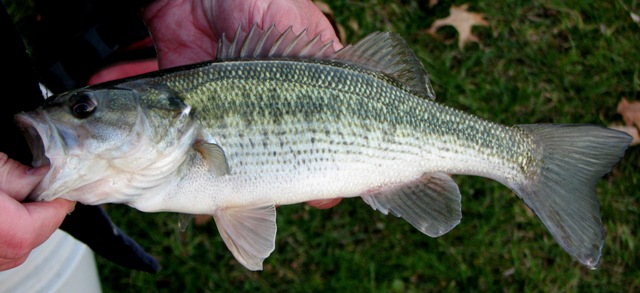Spotted Bass
(Micropterus punctulatus )

The spotted bass is a popular sport fish and like the other two black bass species they have been introduced well outside their native range. In Ohio they are native to the Ohio River system and its tributaries.
Description
Spotted bass have a fairly large mouth that extends to the eye but not beyond the rear edge when the mouth is closed. This characteristic distinguishes it from the largemouth bass where the back of the mouth does extend past the eye. Spotted bass also have a rough patch of small teeth on the center of their tongue largemouth bass do not have this. Young spotted and smallmouth bass have an orange color in the center of their tail, juvenile largemouth bass do not. Spotted bass have a similar coloration compared to a largemouth bass. Both have a black stripe that extends laterally down the side of the body instead of the vertical bars of a smallmouth bass. Spotted and largemouth bass are also lighter colored than smallmouth bass with more of a green or silvery background color instead of the bronze or brown color of a smallmouth bass. Spotted bass have rows of spots on their lower sides below the dark lateral stripe, these are faint or absent on largemouth bass.
Habitat and Habits
Spotted bass are native to the Ohio River drainage but not the Lake Erie drainage in Ohio. Their preferred habitat is long deep pools of medium to large streams and rivers. They avoid both shallow, heavily vegetated, still, waters preferred by largemouth bass, and the swift flowing rocky waters preferred by smallmouth bass. They are most common in the Ohio River and some of its larger tributaries such as the Scioto, Muskingum, and Hocking Rivers. They are also found in some of the larger southern Ohio Reservoirs such as East Fork and Caesar Creek. In Reservoirs they are typically found near steep drop offs along main lake shorelines.
Reproduction and Care of the Young
Spotted bass spawn between mid-April and mid-June. The males construct nests over rocky or gravely substrate near cover. They will spawn in deeper water than the other two species of black bass found in Ohio, sometimes at depths of up to 40 feet. Females lay between 1,100 and 47,000 eggs. Males guard the eggs and fry for a short time after they hatch.